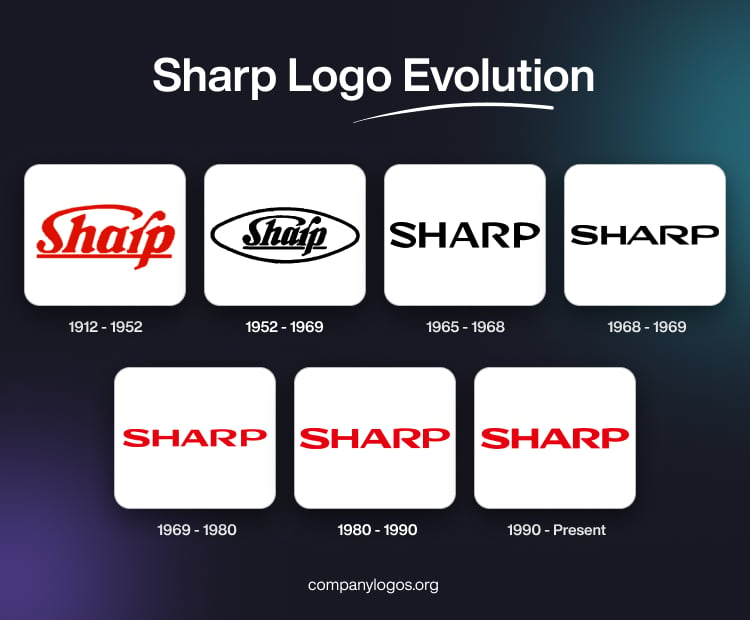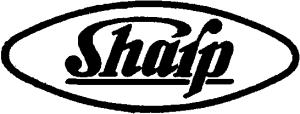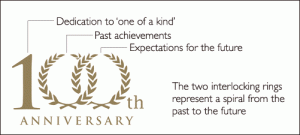
Sharp is a world-renowned Japanese company that manufactures a host of products, such as solar panels, televisions, monitors, microwaves, phones, and calculators. Based in Sakai, the company was founded in 1912 by Tokuji Hayakawa.
The Sharp logo has undergone several evolutions since the inception of the company. It echoes the company’s origins and its journey to becoming a global electronics giant. Interestingly, the name and corporate symbol trace back to the invention of the “Ever-Ready Sharp Pencil”. The article delves into the various logo iterations of Sharp, among other details.
The Genesis of the Sharp Logo (1912 – 1952)
The original logo featured the brand name in red written in a calligraphic script where the letter “S” had an extended arm that stretched over “h” and “a” to finish over “r”. The upward glyph of the letter “r” was also extended upwards as a nod to the sharp pencil. The logotype was underlined to signify its special status and market position.

(1952 – 1969)
The subsequent Sharp logo refined the earlier wordmark and rendered it in black against a white background. The letters of the wordmark were made compact and surrounded by an oval with a thick black outline.

(1965 – 1968)
In the logo iteration of 1965, the oval was discontinued, and the logo featured the brand name in black uppercase against a white background. The letters forming the wordmark had sharp cuts and thick edges. The top of the letter “A” was flattened, while the letters “S” and “R” had unique shapes.

(1968 – 1969)
The logo iteration of 1968 saw the letters of the wordmark flattened and rendered in a modern geometric sans-serif typeface. The letter “S” was straightened a bit, while the middle bar of the letter “R” was extended.

(1969 – 1980)
In 1969 the colour of the logo was changed to red, and the glyphs of the wordmark rendered in a custom sans-serif typeface were made sharper.

(1980 – 1990)
The 1980 logo more or less retained the previous iteration with subtle changes in the proportions and spacing of the glyphs.

(1990 – Present)
The logo of 1990 continues with its distinctive, geometric sans-serif font and vivid red. The open glyph of the letter “R” points out the fact that the company is open to new developments and develops market-centric products.

(2012) (100th Anniversary Logo)
In 2012, a special commemorative logo was introduced for Sharp’s 100th anniversary. It featured intertwined rings symbolising the company’s evolution from past to future. The accompanying wordmark was written using a modern sans-serif typeface.

The Elements of the Sharp Logo
Font
The wordmark used in the Sharp logo is rendered using a custom geometric sans-serif font. The font was created expressly for Sharp’s brand needs, and it conveys a sense of clarity, intelligence, and contemporary appeal. The letters of the logo appear to be stretched horizontally and flattened. Also, the top of the letter “A” is shown to be flattened, while the letters “R”, “P”, and “S” have curves.
Colour
The Sharp logo employs “Sharp Red” as its colour. This vibrant red hue conveys energy, reliability, and creative spirit.
The History of Sharp
Sharp Corporation came into existence in 1912, when Tokuji Hayakawa established a small metal workshop in Tokyo. He soon invented the “Tokubijō” snap buckle. Just a few years later, in 1915, he created the “Ever-Sharp” mechanical pencil. This was a breakthrough product that gave the company its name. However, the devastating Great Kantō Earthquake of 1923 destroyed Sharp’s Tokyo factory. The company was thus forced to relocate to Osaka, where it rebuilt and transitioned into electronics.
In 1925, Sharp produced Japan’s first crystal radio sets, which marked its entry into consumer electronics. By 1953, the company had developed Japan’s first domestically produced television.
The following decades were defined by innovation and expansion. In 1964, Sharp introduced the world’s first transistor calculator. And during the 1970s it became a leader in display technology by developing liquid crystal displays (LCDs) and launching the first pocket-sized LCD calculator in 1973. By the 1980s, Sharp had expanded internationally with subsidiaries across the United States, Europe, and Asia. At the same time, it continued to innovate in home appliances, televisions, and audio products.
In the late 20th century, Sharp built a strong reputation in LCD and semiconductor technology. It powered devices from leading global brands, including Apple and Nintendo. It also developed advanced renewable energy solutions with its solar-powered calculators in the 1990s. The company became a major force in flat-screen televisions during the 2000s, particularly through the Aquos brand launched in 2001.
Despite these successes, Sharp struggled financially in the early 2010s as competition in the television market intensified. It led to major restructuring and losses. In 2016, it became the first major Japanese electronics company to be acquired by a foreign firm when Taiwan’s Foxconn (Hon Hai Precision Industry Co.) purchased a controlling stake.
Since then, Sharp has staged a revival. It regained profitability by streamlining operations and focusing on strategic growth areas such as smart appliances, energy solutions, 5G and IoT technologies, and AI-driven devices. Thus, from its beginnings with a mechanical pencil to becoming a leader in LCDs and consumer electronics, Sharp’s story is of resilience, creativity, and the pursuit of innovation. It is true to its philosophy of making products that others want to imitate.
Interesting Facts About Sharp
- Sharp is named after the “Ever-Sharp” mechanical pencil invented by founder Tokuji Hayakawa in 1915. This product was so innovative that it not only shaped the company’s name but also symbolised its spirit of creativity.
- In 1953, Sharp manufactured Japan’s first domestically produced television set. This product made Sharp a household name in the country’s postwar recovery era.
- Sharp was one of the first companies to develop and commercialise liquid crystal display (LCD) technology. Its LCD calculators in the 1970s and later Aquos LCD TVs helped change the face of consumer electronics.
- Sharp was a trailblazer in renewable energy. It developed solar-powered calculators in the 1990s and later became one of the world’s leading solar panel manufacturers.
- Sharp’s LCD screens have been used in iconic products by companies like Apple and Nintendo. For example, many early iPhones and Nintendo handheld consoles used Sharp displays.
- In 2016, Sharp made history when Taiwan’s Foxconn (Hon Hai Precision Industry Co.) acquired a controlling stake. This marked the first time a large Japanese electronics company was purchased by a foreign entity.
- The Aquos line of LCD TVs, launched in 2001, became one of Sharp’s most successful and globally recognised consumer electronics brands.
- While known for TVs, calculators, and appliances, Sharp also makes products in health, business solutions, energy, and even robotics. It shows the wide reach of its technology.
- Since its inception, Sharp has been known for industry “firsts”, which include Japan’s first radio, first television, first transistor calculator, and first solar-powered calculator. These earned Sharp a reputation as an innovation-driven company.
- Sharp’s guiding philosophy has long been about “making products that others want to imitate.” This reflects its commitment to innovation and leadership in the tech world.
Finally
The Sharp logo has evolved over the years to become an internationally recognised design. Each change in the logo reflects milestones in the company’s history, whether conducting breakthrough inventions or expanding globally. Each logo iteration is anchored by a bold typographic and colour identity that communicates Sharp’s ongoing commitment to innovation and clarity.